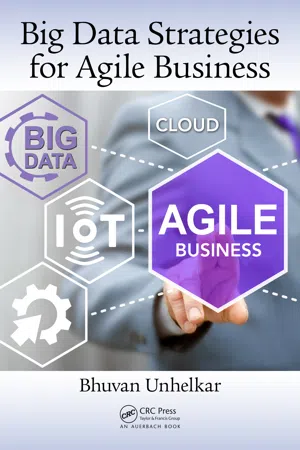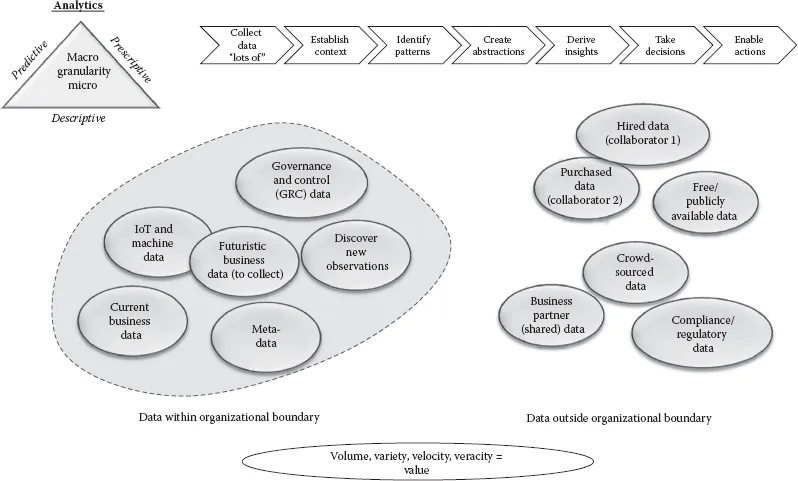
eBook - ePub
Big Data Strategies for Agile Business
Bhuvan Unhelkar
This is a test
- 503 páginas
- English
- ePUB (apto para móviles)
- Disponible en iOS y Android
eBook - ePub
Big Data Strategies for Agile Business
Bhuvan Unhelkar
Detalles del libro
Vista previa del libro
Índice
Citas
Información del libro
Agile is a set of values, principles, techniques, and frameworks for the adaptable, incremental, and efficient delivery of work. Big Data is a rapidly growing field that encompasses crucial aspects of data such as its volume, velocity, variety, and veracity. This book outlines a strategic approach to Big Data that will render a business Agile. It discusses the important competencies required to streamline and focus on the analytics and presents a roadmap for implementing such analytics in business.
Preguntas frecuentes
¿Cómo cancelo mi suscripción?
¿Cómo descargo los libros?
Por el momento, todos nuestros libros ePub adaptables a dispositivos móviles se pueden descargar a través de la aplicación. La mayor parte de nuestros PDF también se puede descargar y ya estamos trabajando para que el resto también sea descargable. Obtén más información aquí.
¿En qué se diferencian los planes de precios?
Ambos planes te permiten acceder por completo a la biblioteca y a todas las funciones de Perlego. Las únicas diferencias son el precio y el período de suscripción: con el plan anual ahorrarás en torno a un 30 % en comparación con 12 meses de un plan mensual.
¿Qué es Perlego?
Somos un servicio de suscripción de libros de texto en línea que te permite acceder a toda una biblioteca en línea por menos de lo que cuesta un libro al mes. Con más de un millón de libros sobre más de 1000 categorías, ¡tenemos todo lo que necesitas! Obtén más información aquí.
¿Perlego ofrece la función de texto a voz?
Busca el símbolo de lectura en voz alta en tu próximo libro para ver si puedes escucharlo. La herramienta de lectura en voz alta lee el texto en voz alta por ti, resaltando el texto a medida que se lee. Puedes pausarla, acelerarla y ralentizarla. Obtén más información aquí.
¿Es Big Data Strategies for Agile Business un PDF/ePUB en línea?
Sí, puedes acceder a Big Data Strategies for Agile Business de Bhuvan Unhelkar en formato PDF o ePUB, así como a otros libros populares de Business y Gestione dell'informazione. Tenemos más de un millón de libros disponibles en nuestro catálogo para que explores.
Información
Chapter 3
Data Science—Analytics, Context, and Strategies
Chapter Objectives






This chapter is mainly based on the second module of the Big Data Framework for Agile Business (BDFAB): data science—analytics, context, and technology. Specifically, as shown in Figure 2.1, this module draws attention to data, its various types and categories, and their utilization in analytics. Setting the context of a data point and the role of hex elementization in doing so is also discussed in this chapter. Furthermore, this chapter explains the crucial importance of granularity in data and analytics, and the setting of the OGL. Data science is presented as a discipline responsible for adopting and using Big Data in an iterative and incremental manner.
Data Science: Analytics, Context, and Strategies
Understanding the Importance of Data Science
Data science is a broad-ranging term that represents the technologies and analytics of Big Data. Additionally, though, data science can be understood as a discipline of utilizing technologies and analytics to convert data into actionable knowledge. Data science includes data mining, analytics (statistics), process modeling, machine learning (ML), parallel processing, and associated aspects of data management. The application of analytics to this data is the main step in arriving at insights. Therefore, data analytics remains at the core of data science. Data science, however, is closer to the business leadership and strategic decision making than data analytics. The evolution of data to actionable knowledge requires a specialist discipline that includes the study of data, its characteristics, its context in analytics, and eventually its value in business agility. These aforementioned activities require a wide coverage of various other disciplines within the organization and collaboration with many cross-functional teams. Therefore, the work of data science is interdisciplinary.
While analysis of data can focus on using the statistical expertise and management of data on the technical aspects, data science focuses on the strategic aspect of producing business value from data. This strategic aspect of data science requires domain knowledge of the industry where it is applied. For example, domain knowledge of the banking, finance, insurance, telecom, medical, and education industries is important in developing corresponding data strategies. Consider the following examples where data science provides value by combining the science of data with the domain knowledge:








Data science thus has wide-ranging applications in business decision making. Many internal organizational disciplines and functions provide input into data science. These are the disciplines of business strategies, project management, enterprise architecture, process modeling, solutions development, and quality assurance and testing. These disciplines complement those of data science. Figure 3.1 shows the effort involved in categorizing data, finding the correlation, undertaking analytics, and presenting the insights in an easy-to-use way for the end user.

Figure 3.1Data analytics, data categories (pools), and a subprocess for data transformation.
Data science considers the following in order to provide business value:




Índice
- Cover
- Half-Title
- Title
- Copyright
- Dedication
- Series
- Contents
- List of Figures
- List of Tables
- Foreword
- Preface
- Acknowledgements
- About the Author
- Domain Terms and Acronyms
- SECTION I INTRODUCTION TO BIG DATA STRATEGIES AND OUTLINE OF BIG DATA FRAMEWORK FOR AGILE BUSINESS (BDFAB)
- SECTION II ANALYTICS, PROCESSES, TECHNOLOGIES, ARCHITE CTURE, AND DATABASES WIT HIN THE BDFAB
- SECTION III QUALITY, GRC, PEOPLE AND THEIR UPSKILLING, AND AGILE BUSINESS WIT HIN THE BDFAB
- SECTION IV CASE STUDIES IN BANKING, HEALTH, AND EDUCATION
Estilos de citas para Big Data Strategies for Agile Business
APA 6 Citation
Unhelkar, B. (2017). Big Data Strategies for Agile Business (1st ed.). CRC Press. Retrieved from https://www.perlego.com/book/1515920/big-data-strategies-for-agile-business-pdf (Original work published 2017)
Chicago Citation
Unhelkar, Bhuvan. (2017) 2017. Big Data Strategies for Agile Business. 1st ed. CRC Press. https://www.perlego.com/book/1515920/big-data-strategies-for-agile-business-pdf.
Harvard Citation
Unhelkar, B. (2017) Big Data Strategies for Agile Business. 1st edn. CRC Press. Available at: https://www.perlego.com/book/1515920/big-data-strategies-for-agile-business-pdf (Accessed: 14 October 2022).
MLA 7 Citation
Unhelkar, Bhuvan. Big Data Strategies for Agile Business. 1st ed. CRC Press, 2017. Web. 14 Oct. 2022.